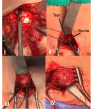Mini-open transosseous repair with bursal augmentation improves outcomes in massive rotator cuff tears
- PMID: 39824871
- PMCID: PMC11748612
- DOI: 10.1038/s41598-025-85520-2
Mini-open transosseous repair with bursal augmentation improves outcomes in massive rotator cuff tears
Abstract
Treatment of Massive rotator cuff tears (MRCT) is difficult, with high rates of retears. Using biological augmentation in the form of the highly vascular subacromial bursa, was used to improve tendon healing. This work aimed to evaluate the results of arthroscopic guided mini-open transosseous repair with bursal augmentation in the treatment of MRCTs in a five-step approach. Forty-eight patients, with a mean age of 63.15 years, were treated with this technique. The patients were evaluated with the constant, UCLA and VAS scores. Plain X-rays were performed to evaluate the CSA and MRI was done to confirm the diagnosis of MRCT and determine the degree of fatty degeneration. Ultrasound was done at 1 year post-operative to determine any retears. The mean follow-up period was 29 months ± 4.95. The Constant and UCLA mean scores improved from (52.52) to (89) and (13.2) to (30.5) respectively (p < 0.0001). The post-operative active flexion and abduction improved from a mean of (112° to 170°) and (136.2° to 167°) respectively, while ER improved from (62.8° to 70°) with their p values (p < 0.0001). Pain improved from a mean VAS of (5.85) to (0.5) (p < 0.0001). No deterioration of function was noted throughout the follow-up period, and no retears occurred on post-operative ultrasound evaluation. Mini-open transosseous repair with bursal augmentation in the treatment of MRCT is an effective and low-cost method that achieves satisfactory results with no retears.
Keywords: Biological bursa; Massive rotator cuff tear; Mini-open.
© 2025. The Author(s).
Conflict of interest statement
Competing interests: The authors declare no competing interests. Ethical consideration: All patients had undergone informed consent and the study was registered on clinicaltrials.gov with the identifier: NCT06242158.
Figures




Similar articles
-
Clinical outcomes of medialized single-row repair with fascia lata graft augmentation for large and massive rotator cuff tears.J Shoulder Elbow Surg. 2024 Mar;33(3):e153-e161. doi: 10.1016/j.jse.2023.07.020. Epub 2023 Aug 22. J Shoulder Elbow Surg. 2024. PMID: 37619927
-
Anchorless Arthroscopic Transosseous and Anchored Arthroscopic Transosseous Equivalent Rotator Cuff Repair Show No Differences in Structural Integrity or Patient-reported Outcomes in a Matched Cohort.Clin Orthop Relat Res. 2020 Jun;478(6):1295-1303. doi: 10.1097/CORR.0000000000001151. Clin Orthop Relat Res. 2020. PMID: 32039957 Free PMC article.
-
Massive rotator cuff tears with short tendon length can be successfully repaired using synthetic patch augmentation.J Shoulder Elbow Surg. 2023 Oct;32(10):2089-2096. doi: 10.1016/j.jse.2023.03.037. Epub 2023 May 12. J Shoulder Elbow Surg. 2023. PMID: 37178963
-
Arthroscopic Incomplete Repair Using a "Hybrid Technique" for Large to Massive Rotator Cuff Tears: Clinical Results and Structural Integrity.Arthroscopy. 2018 Jul;34(7):2063-2073. doi: 10.1016/j.arthro.2018.02.013. Epub 2018 May 2. Arthroscopy. 2018. PMID: 29730212
-
Preservation of bursal-sided tendon in partial-thickness articular-sided rotator cuff tears: a novel arthroscopic transtendon anatomic repair technique.Arch Orthop Trauma Surg. 2016 Dec;136(12):1701-1708. doi: 10.1007/s00402-016-2546-1. Epub 2016 Aug 6. Arch Orthop Trauma Surg. 2016. PMID: 27498108
Cited by
-
Effect of mini-open rotator cuff repair combined with intraoperative cocktail therapy in the treatment of rotator cuff injury: a prospective comparative study between the cocktail therapy and the control group.Arch Orthop Trauma Surg. 2025 Apr 17;145(1):246. doi: 10.1007/s00402-025-05872-2. Arch Orthop Trauma Surg. 2025. PMID: 40244435 Clinical Trial.
-
Combined Subacromial Bursal Stem Cell Therapy and Platelet-Rich Plasma Alongside Arthroscopic Rotator Cuff Surgery Reduces Postoperative Pain and Improves Functional Outcomes: A Retrospective Study.J Clin Med. 2025 Aug 7;14(15):5590. doi: 10.3390/jcm14155590. J Clin Med. 2025. PMID: 40807209 Free PMC article.
References
-
- Galatz, L. M. et al. The outcome and repair integrity of completely arthroscopically repaired large and massive rotator cuff tears. J Bone Joint Surg Am86, 219–224. 10.2106/00004623-200402000-00002 (2004). - PubMed
-
- Nobuhara, K., Hata, Y. and Komai, M. Surgical procedure and results of repair of massive tears of the rotator cuff. Clin. Orthop. Relat. Res. 1994, 54–59. - PubMed
-
- Gerber, C., Fuchs, B. & Hodler, J. The results of repair of massive tears of the rotator cuff. J Bone Joint Surg Am82, 505–515. 10.2106/00004623-200004000-00006 (2000). - PubMed
Publication types
MeSH terms
LinkOut - more resources
Full Text Sources
Medical

